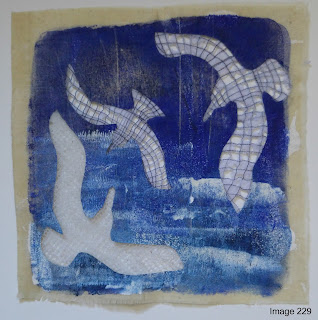Sample 5 (Image 236: max dimensions 9cmWx10.5cmH)
Aim - to make a bird brooch (for our branch of the Embroiderers' Guild). It takes inspiration from Seasalt.
Background - two small pieces of white cotton. Inktense pencils after stitching to give the grey on the tail and the yellow beak. Stitched piece bonded onto pelmet vilene with PVA. Trimmed. Coated back and front with acrylic wax.
Stitching - double running stitch, kantha overstitched with fly stitch in places.
Observations
- a splash of yellow is all this design needs to lift it
- acrylic wax and pelmet vilene make a surprising resilient structure.
Sample 6 (Image 237)
Aim - to make a distressed gull string
Background - image pencilled onto Regular 70g Lutradur and coloured with Inktense pencils (Image 238)
Image 239 - Inktense pencils given a wash with water to make them permanent. Note how beautifully the colour flows on the Lutradur.
Image 249 - free machine stitched (no hoop required as Lutradur stable to stitch).
Image 241 - cut out - used scissors but in hindsight soldering iron would have given better edges.
Image 242 - distressed with heat gun. When lit gives wonderful shadows.
Stitching - free machine embroidery using variegated grey Gutermann Sulky
Observations - this has definite possibilities though it is a bit too gully...needs abstraction! (or maybe just more heat!!!! i.e extreme distressing...a little like the extreme metallic rub-ons and extreme hand washing prior to dyeing!)
Sample 7 (Image 243: 26cmWx20cmH)
Aim - to use the monoprint drawing Image 141 (which has proved the most popular to date on Instagram) for extended stitch samples.
Background - using the original image (A5 size) I took one corner which had particularly pleasing brayer marks and enlarged some sections to produce a background and two smaller sections on copier paper. These were all stabilized on light weight iron-on vilene. Once stitched the two smaller pieces were mounted on 3mm foamboard and the larger piece on cardboard.
Stitching
Image 244 - background - blanket stitch in black flower thread.
Image 245 - bottom right panel - applied acrylic painted scrim using free machine embroidery...spool thread visible... and then free-machined sympathetically to print marks using grey mercerised cotton.
Image 246 - top left panel - needle weaving over gull shapes using white DMC Cebelia; fly stitch over heavier brayer marks using black flower thread; free-machine embroidery using grey mercerised cotton.
Observations - as I sat looking at this piece over breakfast, the placement of the smaller panels brought to mind a mobius strip, the eye being constantly taken back into the panel and giving it a sense of movement. Another happy accident that has definite future possibilities. The placement of the smaller panel also isn't the norm, the smaller images being in the forefront. However, it works for me and heightens the movement within the piece.
Sample 8 (Image 247-249)
Aim - to use the monoprint drawing Image 141 (which has proved the most popular to date on Instagram) to incorporate twining.
Background - A5 copy of original image bonded onto 3mm foamboard.
'Stitching' - structure twined to twist sympathetically from print to give impression of movement. Black paper yarn warp and white folded paper yarn weft. Added white paper yarn to give impression of birds in flight. Warp, split, couched through foamboard and then knotted. Additional warp also split and knotted.
Observations - this was my first attempt to incorporate twining into my work, and,
- it would have integrated more sympathetically if there had been some texture in the panel to which it was attached
- the panel to which is was attached should have been smaller (Image 247 showing less panel works better for me)
- the additions to the twining would have been more striking in black (originally these had been in white raffia with some grey markings and more pronounced, but they looked out of place - sorry I didn't take a photo)
- something to think about as I love the texture...and the black and white.
Other stitch samples already on blog: work from summer school with Jan Beaney and Jean Littlejohn, Debbie Lyddon workshop, Lynda Monk workshop, boro-related samples and header image.










































